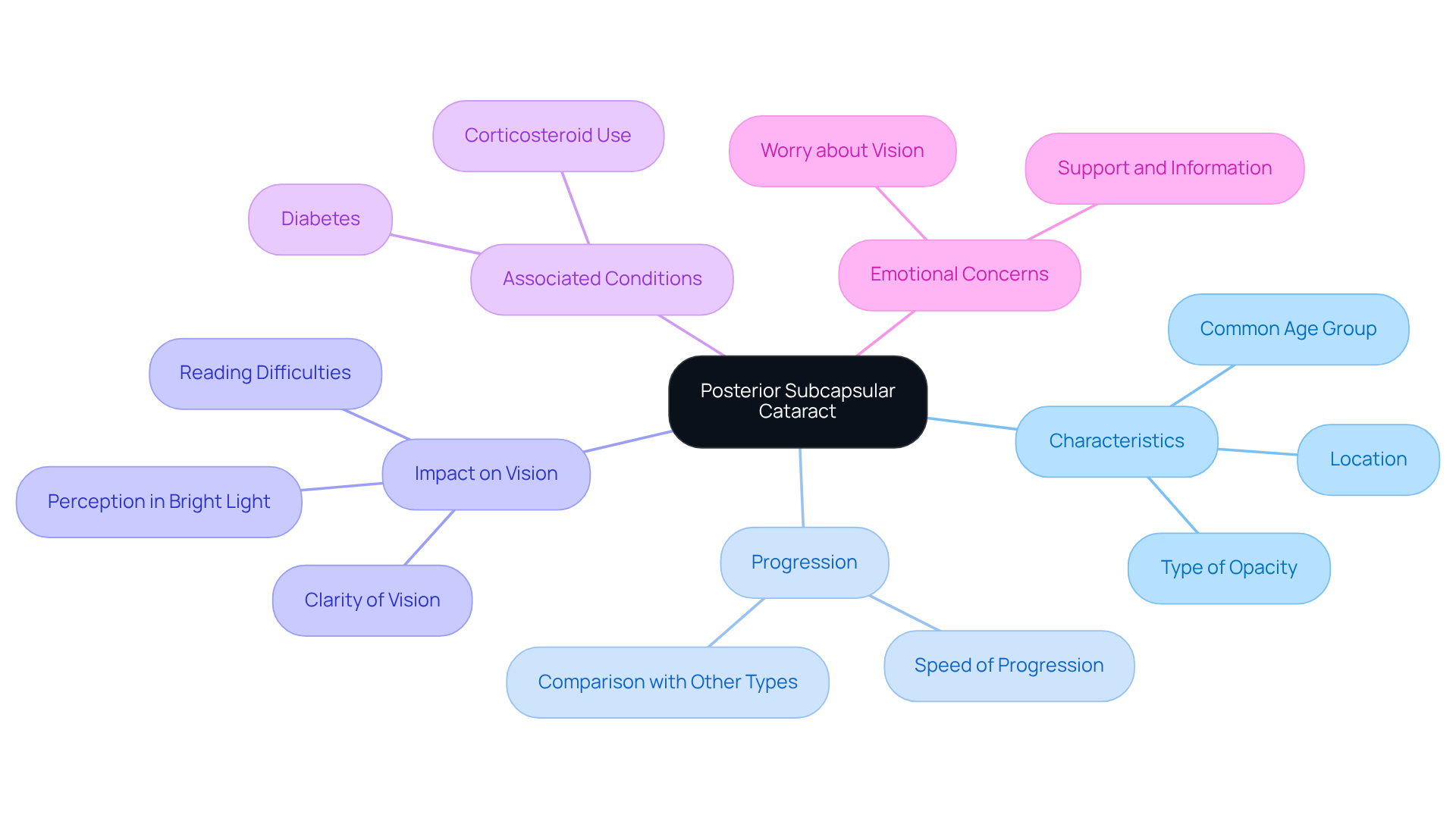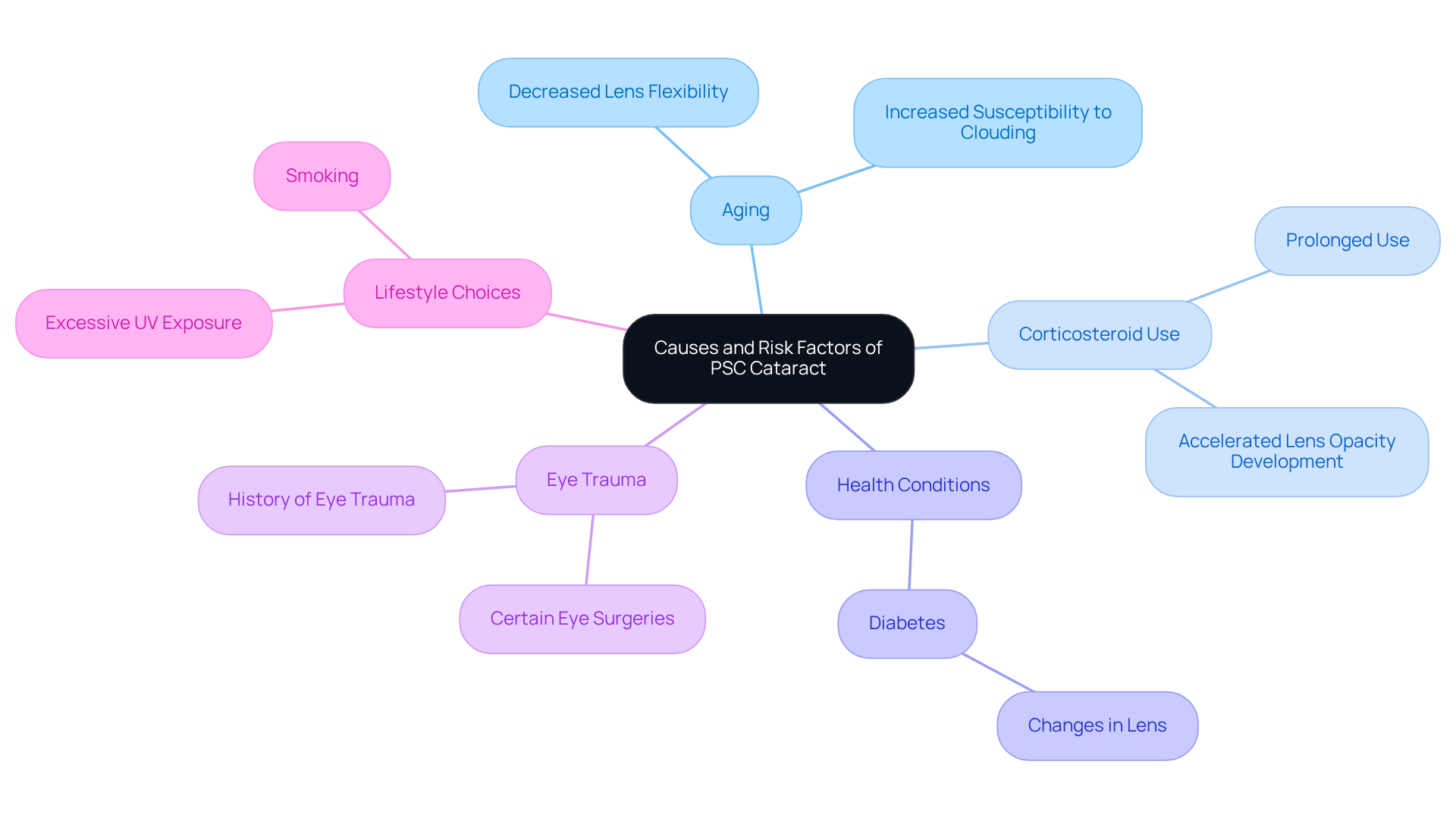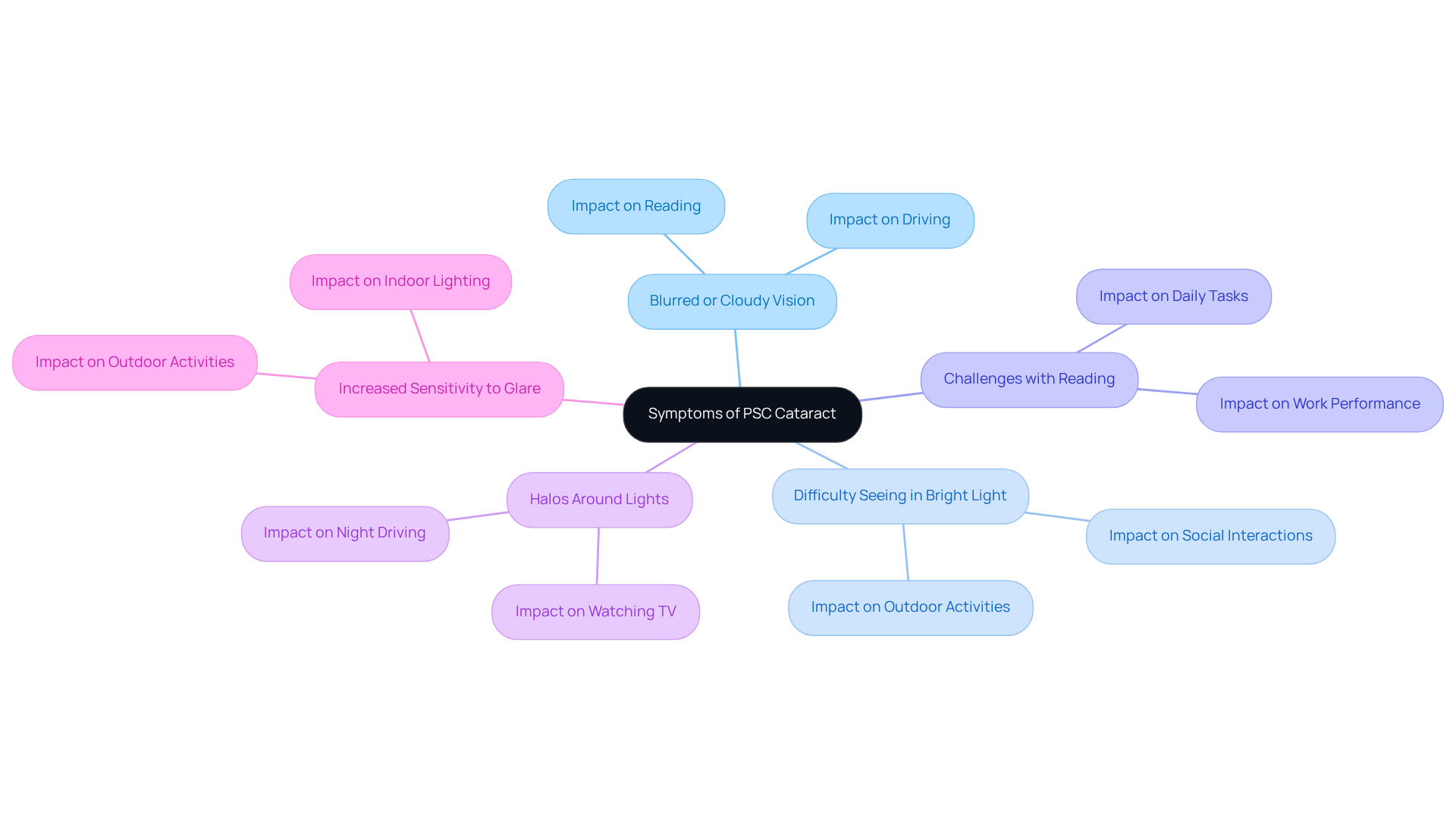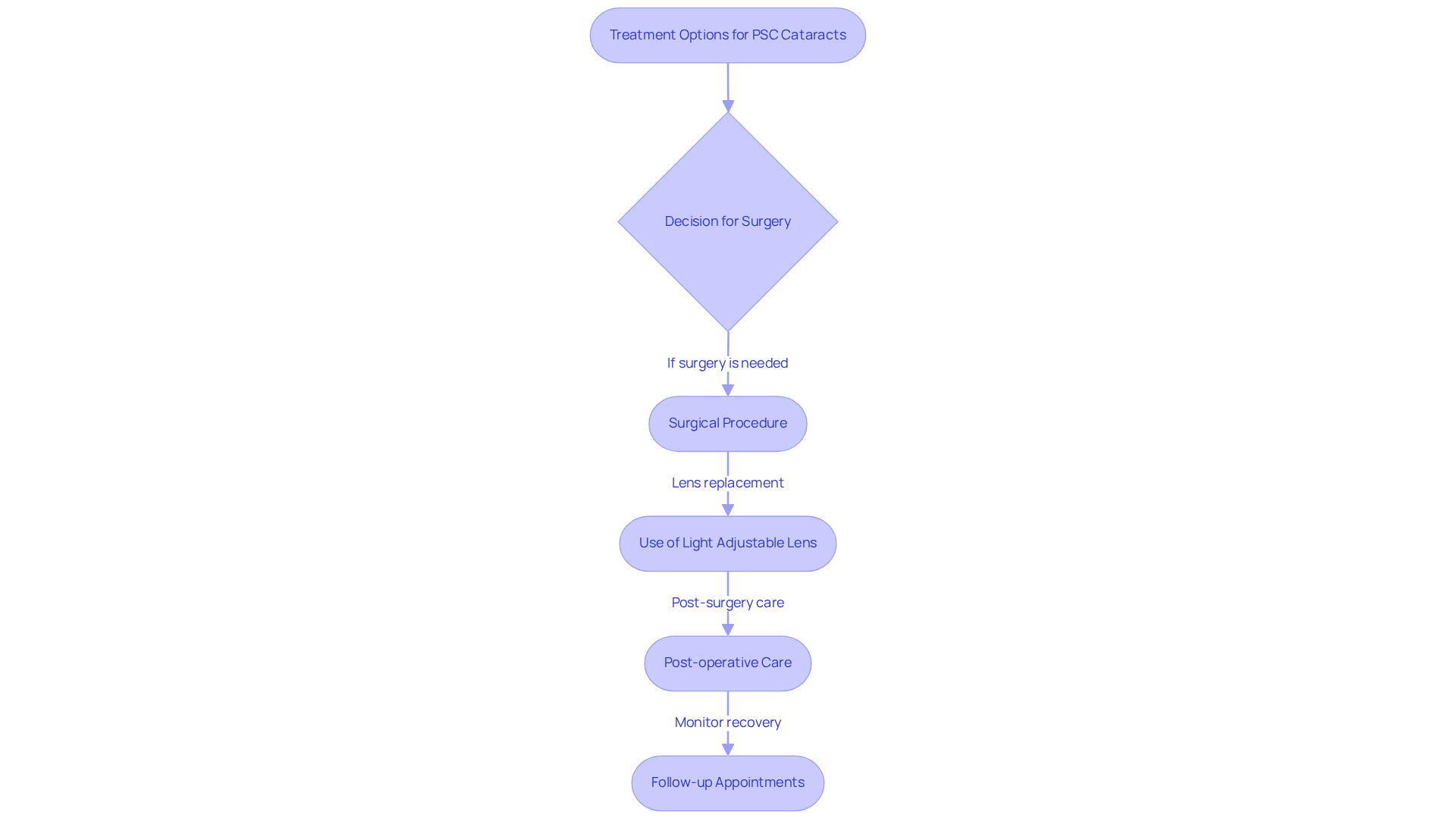Posted by: Northwest Eye in Cataracts on October 21, 2025
Overview
This article aims to help you understand posterior subcapsular (PSC) cataracts, focusing on their causes, symptoms, and treatment options that can greatly affect your vision.
We understand that PSC cataracts can lead to a rapid decline in vision, especially impacting clarity in bright light and during near tasks. It’s common to feel concerned about these changes, and we want to emphasize the importance of surgical intervention to restore your sight.
With advancements like the Light Adjustable Lens technology, there are effective solutions available to help you regain clarity and comfort in your daily activities.
Introduction
Understanding the complexities of PSC cataracts is essential for anyone concerned about their vision health. These specific lens opacities, which form at the back of the eye, can lead to rapid deterioration in sight and significantly affect daily activities. We understand that this can be distressing.
What factors contribute to the development of PSC cataracts, and how can individuals recognize their symptoms before they escalate? It’s common to feel uncertain about these questions. Exploring these topics not only sheds light on the condition but also empowers you to take proactive steps in managing your eye health. We are here to help you through this process.
Define Posterior Subcapsular Cataract
A psc cataract refers to a specific type of posterior subcapsular opacity that develops at the back of the lens, directly beneath the lens capsule. We understand that learning about this condition can be concerning. This type of opacity generally progresses more quickly than other varieties of lens opacities, such as nuclear or cortical types. It’s common to feel worried about how this might affect your vision.
PSC cataract can greatly impact sight by leading to unclear or warped perception, especially in bright light or while reading. We want you to know that you are not alone in this experience. These conditions are often associated with other eye issues, such as diabetes or prolonged use of corticosteroids, and can occur at any age, although they are more common in older adults.
Understanding this definition is crucial for recognizing the implications of psc cataract on overall eye health and the quality of vision. We are here to help you through this process, providing the support and information you need to navigate your concerns about eye health.

Identify Causes and Risk Factors
It’s important to recognize that several factors can contribute to the formation of PSC cataract. We understand that aging can be a concern, as the natural lens of the eye tends to become less flexible and more susceptible to clouding over time.
Other significant risk factors include:
- Prolonged use of corticosteroids, which may accelerate the development of lens opacity.
- Pre-existing health conditions like diabetes, which can lead to changes in the lens.
- A history of eye trauma or certain eye surgeries, which may increase risk.
- Lifestyle choices, such as excessive UV exposure and smoking, which can further heighten the chances of developing PSC cataract conditions.
Recognizing these causes and risk factors is essential for both you and your healthcare provider. Together, we can manage your eye health effectively and ensure you receive the care and support you deserve.

Recognize Symptoms and Impact on Vision
Symptoms of psc cataract can be quite distressing. Many individuals experience:
- Blurred or cloudy vision
- Difficulty seeing in bright light
- Challenges with reading or focusing on nearby objects
- Halos around lights
- Increased sensitivity to glare
These symptoms can significantly hinder daily activities such as driving or reading. We understand how these changes can lead to frustration and a noticeable decline in quality of life.
For instance, some patients have reported that PSC cataract can advance swiftly, with substantial changes in sight occurring within just weeks. Early recognition of these symptoms is crucial. Timely intervention can prevent further deterioration and enhance overall eye health. Routine eye check-ups are essential for observing vision alterations and deciding on the most suitable approach. If lens opacity significantly hinders daily activities, surgical measures may be necessary.
With effective management, including lifestyle adjustments and adherence to medical guidance, individuals can mitigate the impact of psc cataract and maintain a better quality of life. Remember, we are here to help you through this process, ensuring you receive the support you need.

Treatment Options for PSC Cataracts
The primary treatment for psc cataract is surgical intervention, particularly cataract surgery. We understand that facing surgery can be daunting, but this procedure is designed to help restore your vision. During surgery, the cloudy lens is removed and typically replaced with an artificial intraocular lens (IOL). At Northwest Eye, we are proud to offer advancements in surgical methods, such as the innovative Light Adjustable Lens (LAL). This technology enables customized eyesight correction tailored to meet your specific requirements.
The LAL provides a distinct benefit: it allows you to adjust your vision correction after surgery. Many patients have shared their positive experiences, reporting enhanced clarity and a reduced reliance on corrective eyewear. It’s truly inspiring to hear how this advanced technology has helped individuals achieve optimal sight outcomes.
Post-operative care is crucial, as it involves monitoring your recovery and addressing any concerns that may arise. We are here to help you through this process, educating you about the surgical journey, expected outcomes, and the importance of follow-up appointments to ensure your optimal recovery. Statistics indicate that lens surgery effectively restores sight in about 70% to 80% of instances, underscoring its significance in managing psc cataract cases. It’s important to note that PSC cataracts tend to progress faster than other types of cataracts, which may mean surgery is needed sooner.
Understanding these treatment options empowers you to take proactive steps in managing your eye health and improving your vision. Additionally, considering the causes of PSCs—such as age-related changes, UV radiation exposure, and certain medications—can influence your treatment decisions. We are here to support you every step of the way.

Conclusion
Understanding PSC cataracts is essential for recognizing how this specific type of cataract can affect your vision and overall eye health. This condition, characterized by clouding at the back of the lens, can lead to significant visual impairments, particularly in bright light or when reading. We understand that it’s crucial to be aware of the potential implications of PSC cataracts, as they progress more rapidly than other types and can substantially impact your daily activities.
The article highlights various causes and risk factors associated with PSC cataracts, including:
- Aging
- Prolonged corticosteroid use
- Underlying health conditions like diabetes
Symptoms such as blurred vision, increased sensitivity to glare, and difficulty focusing can severely diminish your quality of life. Early recognition and timely intervention are vital to managing these symptoms effectively, often requiring surgical treatment to restore vision.
In light of this information, it’s clear that proactive engagement with your eye health is paramount. Regular eye check-ups, awareness of risk factors, and understanding treatment options can empower you to take charge of your vision. For those experiencing symptoms, seeking medical advice can lead to timely interventions that enhance quality of life. Embracing this knowledge not only fosters better management of PSC cataracts but also promotes a more informed and proactive approach to your overall eye health.
Frequently Asked Questions
What is a posterior subcapsular cataract (PSC cataract)?
A PSC cataract is a specific type of opacity that develops at the back of the lens, directly beneath the lens capsule.
How does a PSC cataract progress compared to other types of cataracts?
PSC cataracts generally progress more quickly than other types of lens opacities, such as nuclear or cortical cataracts.
What vision problems can a PSC cataract cause?
A PSC cataract can lead to unclear or warped vision, particularly in bright light or while reading.
Are there any associated conditions with PSC cataracts?
Yes, PSC cataracts are often associated with other eye issues, such as diabetes or prolonged use of corticosteroids.
At what age can PSC cataracts occur?
PSC cataracts can occur at any age, but they are more common in older adults.
Why is it important to understand PSC cataracts?
Understanding PSC cataracts is crucial for recognizing their implications on overall eye health and the quality of vision.






